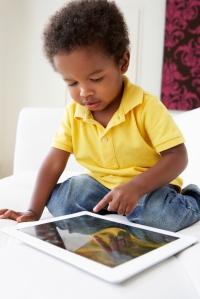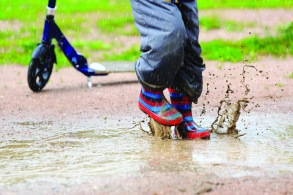Is there anything better than hearing a young child laugh as they jump in a rain puddle, run around the playground, or make pies out of mud? This may not be what is seen at some child care programs today. What happened to outdoor play for young children?
The American Journal of Preventative Medicine found that only 3 in 10 children in full day child care programs got at least 60 minutes a day outside. Other studies suggest children are outside for only 33-36 minutes a day.
During my time in early childhood special education, I would provide services for children at child care centers. Many providers would make statements such as, “He is just bouncing off the walls and won’t focus on an activity.” Upon looking further into the daily routine, many children were outside for only about 25-30 minutes every morning. During collaboration with other early childhood professionals, it was discovered that less outdoor play time was becoming a trend. Consequently, there was an increase in behavioral problems in the classroom that required services from a behavioral specialist.
“Children cannot bounce off the walls if we take away the walls.”
– Erin Kenny
So why is this?
- Some providers feel that children are not learning, and they cannot meet standards through outside play. There are many ways to meet standards through outdoor play. Children can work on their gross and fine motor skills, learn about health and physical exercise, gain valuable social skills while playing with others, explore and learn about the world/environment, take risks, learn safety rules, and burn off built-up energy.
 There is an increase in screen time and technology for young children, which could limit some children’s access to outdoor play. While technology is increasing rapidly in today’s society, there may be a time and appropriate way to incorporate it into a curriculum for children, but it should never replace outdoor play time. It is important to find a balance with how technology is used and when it is offered.
There is an increase in screen time and technology for young children, which could limit some children’s access to outdoor play. While technology is increasing rapidly in today’s society, there may be a time and appropriate way to incorporate it into a curriculum for children, but it should never replace outdoor play time. It is important to find a balance with how technology is used and when it is offered.- Safety is a factor. Children should have access to safe equipment and a safe location/neighborhood with adequate supervision. Safety is a very important concern, and should be taken into consideration when planning all outdoor activities, using equipment, and gathering proper attire for the current season. Collaboration between facility directors and public safety officials should also take place if there are safety concerns with neighborhood location. This ensures that children will have a safe outdoor environment to explore and play.
- Children are missing outdoor time as a consequence of difficult behaviors. Missing outdoor play time as a consequence is not only developmentally inappropriate, but will most likely backfire. Children with difficult behaviors are often the ones who need outdoor play time the most to run off energy in a more open space.
Let’s fix it!
Children use cognitive skills, solve problems, and gain valuable social skills when outside playing. Here are 6 ways to implement outdoor activities that meet standards, while children are also moving their bodies, exploring, and being an active learner:
- Create outdoor learning opportunities. Bring activities and materials typically used indoors and set up outside. Many require minimal set up and basic instruction. For example, if you plan to do a free paint activity on easels inside, set the easels up outside and allow the children to paint outdoors.
- Play fun movement games. Have children run, jump, go down a slide, through a tunnel and across a low balance beam on the ground to get their bodies moving.
 Use the different seasons to encourage outdoor exploration. Have children explore jumping in a puddle after a rainstorm. Set up a bucket and ruler to measure how much it rained or snowed. Have a picnic snack outside on a nice day during the spring or summer. Note: Always follow weather safety regulations and make sure children wear appropriate outdoor attire for the current season.
Use the different seasons to encourage outdoor exploration. Have children explore jumping in a puddle after a rainstorm. Set up a bucket and ruler to measure how much it rained or snowed. Have a picnic snack outside on a nice day during the spring or summer. Note: Always follow weather safety regulations and make sure children wear appropriate outdoor attire for the current season.- Encourage children to provide input. They will likely have some great ideas on outside play ideas or materials to use, and be more engaged since it was of interest to them.
- Provide opportunities for infants to go outside. Lay a blanket down and do tummy time outside. Listen for sounds such as birds, cars, and planes. Take infants for a walk in a stroller or infant buggy.
- Include free play! Let children run, jump, swing, and move their bodies.
When it comes to outside, physical play, children need a minimum of 60 minutes a day. If the weather does not allow for a full 60 minutes of outdoor play, still provide opportunities for physical activity. Set up an indoor obstacle course, play with a parachute, or play a Simon Says game with motor movements.
“The best classroom and the richest cupboard is roofed only by the sky.”
– Margaret McMillan
Back to blog listing